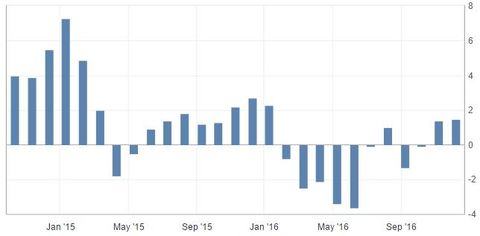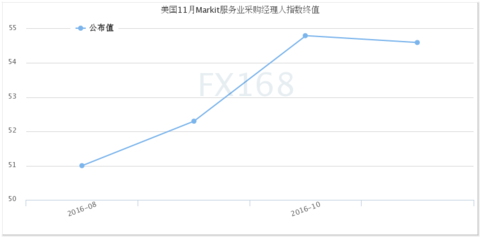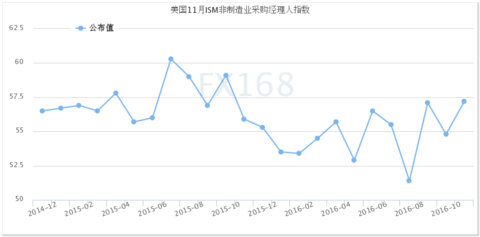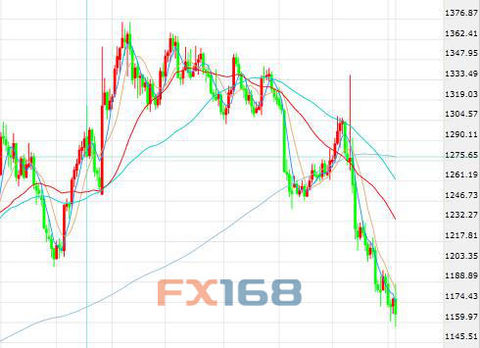The company’s data is to raise interest rates and force gold to continue to be sold down.
International spot gold fell nearly 1% on Monday (December 5th), and the US market dropped to a low of $1157.00 per ounce in intraday trading, once again falling to a 10-month low. After the Italian referendum failed on Monday, investors quickly came from Italy. Political instability has escaped and European stocks have soared. Italian Prime Minister Renzi said that he will resign due to the failure of the referendum on Sunday. The euro rebounded from the low of two years against the dollar, and gold once reduced the decline. But gold is still under the pressure of strong European stocks as investors expect the ECB to take action when necessary, and the next ECB meeting is this Thursday. The US data released during the day is relatively strong, posing great pressure on gold. The US employment market condition index in November significantly exceeded expectations; the US ISM non-manufacturing index rose to 57.2 in November, hitting the highest since October 2015; the US Markit service PMI final value was 54.6 in November, and new orders were last August. highest.
The US dollar continued to fall at a high level on Monday. As of press time, the US dollar index fell 0.20% to 100.46 points. US stocks rose on Friday, the Dow rose 0.48% to 19262.97 points; the S&P 500 rose 0.71% to 2207.51 points; the Nasdaq rose 1.22% to 5,319.69 points. Crude oil continued to rise on Monday, the US oil index rose 0.37% to $51.87 per barrel; the oil index rose 0.81% to $54.90 per barrel.
Gold had a short-term rise after the Italian referendum on Sunday, and the price of gold rose by $10. However, it turned down and the price of gold went down all the way, continuing the journey. Analysts said that the decline in gold on Monday was mainly due to the return of market risk sentiment, and safe-haven assets such as gold were no longer favored. Moreover, investors are looking to be able to make their money more profitable in the US or Europe. Since Trump was elected president of the United States, the market is expected to expand infrastructure to stimulate growth and inflation, and US stocks hit new highs, especially as the Dow has already run above 19,000. In contrast, European stock markets are still at the bottom, making them more attractive to investors. Since the US presidential election, gold has been in a downtrend after a short-term rise, and the decline has increased. Although there has been a rebound during the period, it has been short-lived. At present, as the Fed raises interest rates, the speculative net position of gold options and futures is also significantly reduced. According to CFTC data, speculative net long positions on Friday cut the positions of gold and options. Reduced by 17843 to 103392; the lowest point since February.
US November employment market condition index significantly exceeded expectations, December rate hike is further stabilized
The Federal Reserve (FED) data on Monday (December 5) showed that the US November Employment Market Condition Index (LMCI) recorded 1.5, significantly exceeding the expected value of -0.2, with a previous value of 0.7. After the data was released, gold and silver fell short-term and the US dollar index rose.
The Employment Market Status Index reveals the Fed's interpretation of employment. The index is very important for the market to understand the Fed's attitude towards the job market. The Fed has repeatedly stated that the index reflects the labor market situation more realistically than non-agricultural data.

(Changes in the US Job Market Status Index, Source: Investing.com, FX168 Financial Network)
Barclays Capital analysts said: "LMCI statistics use a dynamic model consisting of 19 labor market indicators, which is the index used by the Fed to comprehensively assess employment conditions. The Fed's data only reflects monthly changes. So we can understand the performance of the labor market by comparing the data with the overall situation of the economic development cycle."
As a traditional market drama, and the last employment report before the Fed's December meeting, the US Department of Labor (DOL) released data on Friday showed that the number of non-farm payrolls in the US increased by 178,000 in November, and the market expects an increase of 17.5. Tens of thousands of people, the unemployment rate plummeted to 4.6% in November, the lowest since August 2007. Data show that the number of non-agricultural employment in the United States increased by 178,000 in November, lower than the market expectation of an increase of 175,000, the previous value increased by 161,000; the US unemployment rate in November was 4.6%, the lowest level since August 2007, expected It is 4.9% and the previous value is 5.0%. The US Department of Labor also revised the number of non-farm payrolls in October to an increase of 142,000. However, the salary unexpectedly weak, the average monthly hourly wage rate in the United States fell 0.1% in November, is expected to increase by 0.2%, the previous value increased by 0.4%; the average annual hourly wage rate in the United States in November increased by 2.5%, expected to increase by 2.8%, the previous value It rose by 2.8%. In addition, the average weekly working hours in the United States in November was 34.4 hours, which is expected to be 34.4 hours, and the previous value was 34.4 hours. The US labor force participation rate fell to 62.7% in November, with a previous value of 62.8%. It is worth pointing out that in just one month in November, 446,000 Americans left the labor force, and the number of people leaving the labor force hit a record high of 95.10 million.
After the non-agricultural data was released, market participants were more determined about the Fed’s interest rate hike in December. Bloomberg cited data from the federal funds rate market, pointing out that the market is betting that the Fed’s interest rate hike may be as high as 100% in December.
The LMCI trend usually leads the non-agricultural growth rate of 6-12 months. That is to say, the non-agricultural data lags behind the LMCI index for 6-12 months, which means that the LMCI trend has an important reference for the future non-agricultural long-term trend.
US November Markit service industry PMI final value of 54.6 new orders for the highest since August last year
On Monday (December 5), an industry report released by financial data company Markit showed that the final value of the US purchasing industry purchasing managers index (PMI) in November was slightly lower than the initial value and the final value of last month.
The data shows that the US MARKIT service purchasing managers index (PMI) in November has a final value of 54.6, with an initial value of 54.7 and a final value of 54.8 in October.
50 is a watershed that marks the shrinking or growing of the industry.
The final value of the new MARKIT service industry sub-index in November was 55.4, the highest since November 2015, with an initial value of 55.5 and a final value of 54.0 in October.
The final value of the US MARKIT integrated PMI in November was 54.9, with an initial value of 54.9 and a final value of 54.9 in October.
The final value of the US MARKIT comprehensive new order sub-index in November was 55.5, the highest since August last year, with an initial value of 55.5 and a final value of 54.2 in October.

(US Markit Service Industry Purchasing Managers Index, Source: FX168 Financial Network)
Williamson, chief economist at market research firm Markit, commented that the US economy is growing steadily; surveys show that US manufacturing and services are expanding at a steady rate; robust business survey data will further increase the Fed’s rate hike in December The reason.
US November ISM non-manufacturing index rose to 57.2, hitting the highest since October 2015
An industry report released on Monday (December 5) showed that the US service sector index rose to its highest level since October 2015.
According to data released by the American Institute of Supply Management (ISM), the non-manufacturing Purchasing Managers' Index (PMI) for November was 57.2, estimated at 55.4, and October was 54.8.

(US non-manufacturing purchasing managers index, source: FX168 financial network)
The data is above the 50-point gap, which means the service industry is expanding.
The US sub-industrial activity index for November was 61.7, the highest since October 2015, with an estimated 58.0 and 57.7 in October.
The non-manufacturing employment sub-index in November also hit a record high of 58.2 in October last year.
In November, the non-manufacturing input price index was 56.3, and in October it was 56.6.
The non-manufacturing new orders sub-index for November was 57.0, compared with 57.7 in October.
The ISM non-manufacturing index reflects the level of prosperity of US non-manufacturing business activities and was developed by the association after surveying nearly 400 corporate procurement and supply managers in 60 industries across the United States. These industries include agriculture, mining, construction, transportation, communications, wholesale trade and retail trade.
Outlook outlook
ICBC Standard Bank analyst Tom Kendall believes that "investors are looking for the United States or Europe to get more money from their funds. In the past six months, gold has performed well, because investment is not in inflation. Get the gains; but now the US 10-year bond yield is already high, and the real interest rate is positive, so gold seems to be less attractive because people have found a better return on investment."
JPMorgan economist Michael Feroli released a report on non-farm data last Friday (December 2), saying that unless there is an adverse event, the Federal Reserve’s (FED) rate hike this month "seems to be a matter of fact." It is. The more interesting part of the next meeting of the Federal Open Market Committee (FOMC) will be economic forecasts and bitmaps.
According to data released by the US Department of Labor last Friday, the number of non-agricultural employment increased by 178,000 in November, which was higher than the increase of 142,000 after the repair in October. At the same time, the unemployment rate fell to a nine-year low of 4.6% as the labor force participation rate fell for the second consecutive month.
Before Friday, JP Morgan Chase expects the US dollar appreciation since the US election will cause the Fed's inflation forecast for 2017 to be lower than it was three months ago. But after the unexpectedly low unemployment rate in the non-farm payrolls report in November, JPMorgan Chase has little change in inflation expectations for next year.
The bank pointed out, "For this reason, we believe that the median value of the dot matrix will still reflect the rate hike twice in 2017."
At 00:25 Beijing time, spot gold reported $1,164.30 per ounce, down $12.5, or 1.06%.

[Disclaimer] This article only represents the author's own point of view and has nothing to do with this website. This website is neutral to the statements and opinions in the text and does not provide any express or implied warranty as to the accuracy, reliability or completeness of the content contained herein. The reader is only for reference and bear full responsibility.
(Editor: Chu Xiaoyan HF075)
Baseball Cap,Custom Baseball Caps,Snapback Baseball Cap,Embroidered Baseball Caps
Dongyang City Feilong Cap Co., Ltd. , https://www.zjflcap.com